Marrying Vega and Zen: The AMD Ryzen 5 2400G Review
by Ian Cutress on February 12, 2018 9:00 AM ESTiGPU Gaming Performance, Continued
Rise of the Tomb Raider
One of the most comprehensive games in the gaming benchmark suite is Rise of the Tomb Raider (RoTR), developed by Crystal Dynamics, and the sequel to the popular Tomb Raider which was loved for its automated benchmark mode. But don’t let that fool you: the benchmark mode in RoTR is very much different this time around.
Visually, the previous Tomb Raider pushed realism to the limits with features such as TressFX, and the new RoTR goes one stage further when it comes to graphics fidelity. This leads to an interesting set of requirements in hardware: some sections of the game are typically GPU limited, whereas others with a lot of long-range physics can be CPU limited, depending on how the driver can translate the DirectX 12 workload.

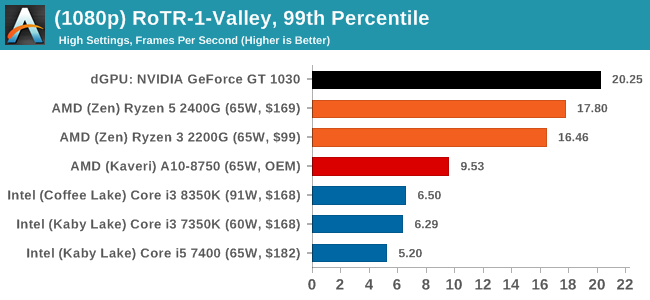
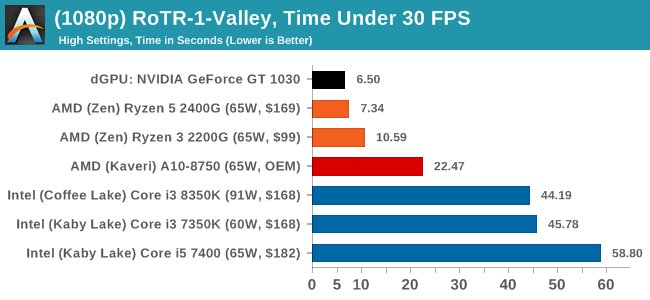
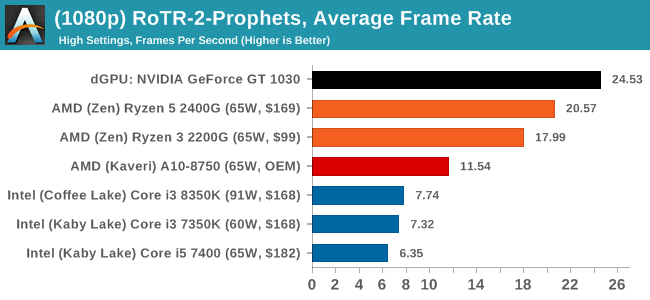
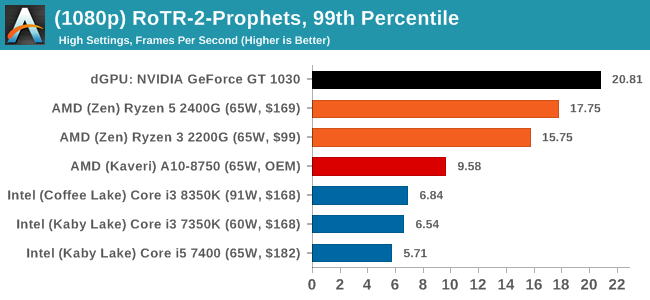
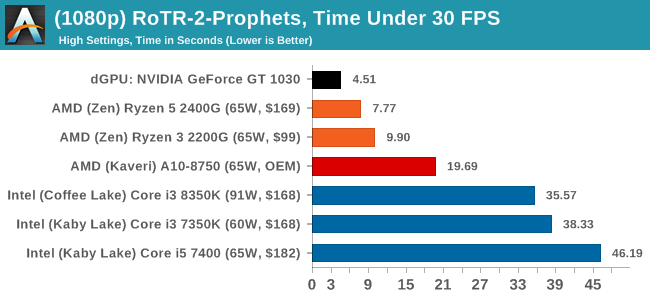

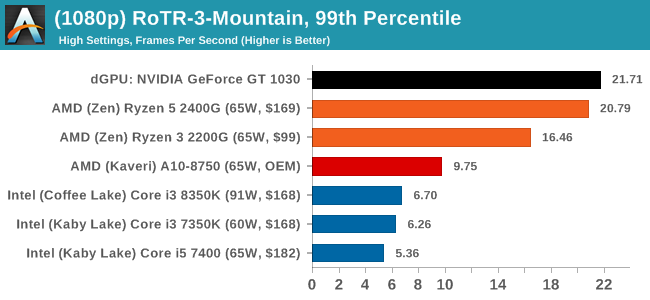
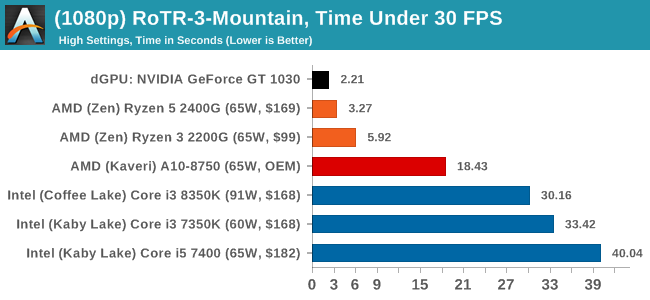
The GT 1030 sweeps the top spot against AMD here, though only by small margins most of the time. The AMD APUs still offer a commanding 2-3x performance jump over Intel's product line, and even more when price is factored into the equation.
Rocket League
Hilariously simple and embodying the elements of pick-up-and-play, Rocket League allows users to jump into a game with other people (or bots) to play football with cars with zero rules. The title is built on Unreal Engine 3, which is somewhat old at this point, but it allows users to run the game on super-low-end systems while still taxing the big ones. Since the release in 2015, it has sold over 5 million copies and seems to be a fixture at LANs and game shows. Users who train get very serious, playing in teams and leagues with very few settings to configure, and everyone is on the same level. Rocket League is quickly becoming one of the favored titles for e-sports tournaments, especially when e-sports contests can be viewed directly from the game interface.
With Rocket League, there is no benchmark mode, so we have to perform a series of automated actions, similar to a racing game having a fixed number of laps. We take the following approach: Using Fraps to record the time taken to show each frame (and the overall frame rates), we use an automation tool to set up a consistent 4v4 bot match on easy, with the system applying a series of inputs throughout the run, such as switching camera angles and driving around.
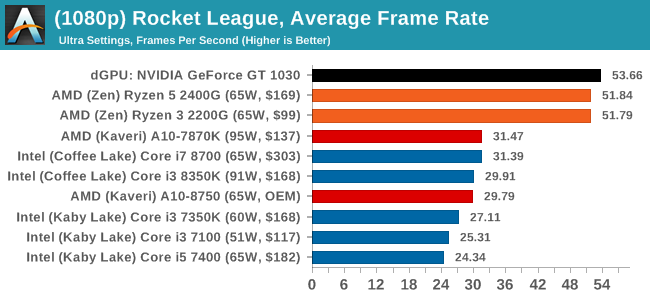
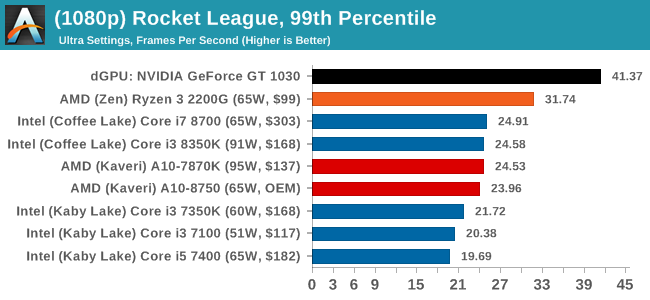

As the more eSports oriented title in our testing, Rocket League is less graphically intense than the others, and by being built on DX9, also tends to benefit from a good single thread performance. The GT 1030 wins again here, most noticably in the 99th percentile numbers, but the AMD chips are hitting 30 FPS in that percentile graph, whereas in the last generation they were getting 30 FPS average. That is a reasonable step up in performance, aided both to the graphics and the high-performance x86 cores. It will be interesting to see how the memory speed changes the results here.










177 Comments
View All Comments
Lolimaster - Monday, February 12, 2018 - link
You don't another model, just disable high clocked pstates till you get the power consumption you want.I can lock my Athlon II X4 to 800Mhz if I desire.
Lolimaster - Monday, February 12, 2018 - link
You can simply set pstate for a lower base clock and also undervolt if you want to reduce power consupmtion even more.Or the lazy way, cTDP in bios to 45w.
Manch - Tuesday, February 13, 2018 - link
Ask and ye shall receivehttps://www.anandtech.com/show/12428/amd-readies-r...
Cryio - Monday, February 12, 2018 - link
This review kind of confused me?It mentioned it's going to compare the A12 9800, but this APU is nowhere to be seen in benchmarks.
Then out of nowhere come A10 7870K, which is fine I guess, but then there's the A10 8750, which doesn't exit, I can asume it's 7850, yet a 7850 non K APU doesn't exist, so what's happening here?
Simon_Says - Monday, February 12, 2018 - link
Will there be any analysis on current and potential future HTPC performance? While it won't support Netflix 4k or UHDBR (yet, thanks Playready 3.0) I for one would still like to know how it handles HDR for local media playback and Youtube, and if it will have the CPU grunt to software decode AV1.Drazick - Monday, February 12, 2018 - link
Does the Ryzen have any hardware based unit for Video trans coding?Could you test that as well (Speed and Quality).
It will be interesting as this CPU can be heaven for HTPC and for NAS with Multimedia capabilities.
Thank You.
GreenReaper - Wednesday, February 14, 2018 - link
It is meant to support up to 4K H.264/5 at 30/60/120FPS for 4K/1440p/1080p resolutions. Obviously it'd be nice to see people testing this out, and the quality of the resulting video.gerz1219 - Monday, February 12, 2018 - link
Still not quite getting the point of this product. Back when it made sense to build an HTPC, I liked the idea of the Bulldozer-era APU, so that I could play games on the TV without having a noisy gaming rig in the living room. But the performance is just never quite there, and it looks like it will be some time before you can spend ~$400 and get 4K gaming in the living room. So why not just buy an Xbox One X or PS4? I also bought a Shield TV recently for $200 and that streams games from my VR/4K rig just fine onto the TV. I'm just not seeing the need for a budget product that's struggling at 1080p and costs about the same as a 4K console.jjj - Monday, February 12, 2018 - link
There are 7+ billion people on this planet and the vast majority of them will never be able to afford a console or to pay a single cent for software - consoles are cheap because they screw you on the software side.Vs the global average you are swimming in money.
And ofc the majority of the PC market is commercial as consumer has been declining hard this decade.
Most humans can barely put food on the table, if that and even a 200$ TV is a huge investment they can afford once every 15 years.
Pinn - Monday, February 12, 2018 - link
But $10 per day on cigarettes is fine?